共计 2893 个字符,预计需要花费 8 分钟才能阅读完成。
一、安装 NFS 服务器
| 服务端节点:yum -y install nfs-utils | |
| mkdir /nfs-{1..6} | |
| cat /etc/exports | |
| /nfs-1 *(rw,no_root_squash,no_all_squash,sync) | |
| /nfs-2 *(rw,no_root_squash,no_all_squash,sync) | |
| /nfs-3 *(rw,no_root_squash,no_all_squash,sync) | |
| /nfs-4 *(rw,no_root_squash,no_all_squash,sync) | |
| /nfs-5 *(rw,no_root_squash,no_all_squash,sync) | |
| /nfs-6 *(rw,no_root_squash,no_all_squash,sync) | |
| systemctl enable nfs-server | |
| systemctl restart nfs-server | |
| 客户端节点:yum -y install nfs-utils | |
| systemctl enable nfs-server | |
| systemctl restart nfs-server | |
| showmount -e nfs-server-IP | |
| Export list for 192.168.1.169: | |
| /nfs-6 * | |
| /nfs-5 * | |
| /nfs-4 * | |
| /nfs-3 * | |
| /nfs-2 * | |
| /nfs-1 * | |
二、部署 PV
| vim pv.yaml | |
| apiVersion: v1 | |
| kind: PersistentVolume | |
| metadata: | |
| name: nfs-pv001 | |
| spec: | |
| capacity: | |
| storage: 2Gi | |
| accessModes: | |
| - ReadWriteOnce | |
| persistentVolumeReclaimPolicy: Retain | |
| storageClassName: nfs | |
| nfs: | |
| path: /nfs-1 | |
| server: 192.168.1.169 | |
| apiVersion: v1 | |
| kind: PersistentVolume | |
| metadata: | |
| name: nfs-pv002 | |
| spec: | |
| capacity: | |
| storage: 2Gi | |
| accessModes: | |
| - ReadOnlyMany | |
| persistentVolumeReclaimPolicy: Retain | |
| storageClassName: nfs | |
| nfs: | |
| path: /nfs-2 | |
| server: 192.168.1.169 | |
| apiVersion: v1 | |
| kind: PersistentVolume | |
| metadata: | |
| name: nfs-pv003 | |
| spec: | |
| capacity: | |
| storage: 2Gi | |
| accessModes: | |
| - ReadWriteMany | |
| persistentVolumeReclaimPolicy: Retain | |
| storageClassName: nfs | |
| nfs: | |
| path: /nfs-3 | |
| server: 192.168.1.169 | |
| apiVersion: v1 | |
| kind: PersistentVolume | |
| metadata: | |
| name: nfs-pv004 | |
| spec: | |
| capacity: | |
| storage: 4Gi | |
| accessModes: | |
| - ReadWriteOnce | |
| persistentVolumeReclaimPolicy: Retain | |
| storageClassName: nfs | |
| nfs: | |
| path: /nfs-4 | |
| server: 192.168.1.169 | |
| apiVersion: v1 | |
| kind: PersistentVolume | |
| metadata: | |
| name: nfs-pv005 | |
| spec: | |
| capacity: | |
| storage: 4Gi | |
| accessModes: | |
| - ReadOnlyMany | |
| persistentVolumeReclaimPolicy: Retain | |
| storageClassName: nfs | |
| nfs: | |
| path: /nfs-5 | |
| server: 192.168.1.169 | |
| apiVersion: v1 | |
| kind: PersistentVolume | |
| metadata: | |
| name: nfs-pv006 | |
| spec: | |
| capacity: | |
| storage: 4Gi | |
| accessModes: | |
| - ReadWriteMany | |
| persistentVolumeReclaimPolicy: Retain | |
| storageClassName: nfs | |
| nfs: | |
| path: /nfs-6 | |
| server: 192.168.1.169 |
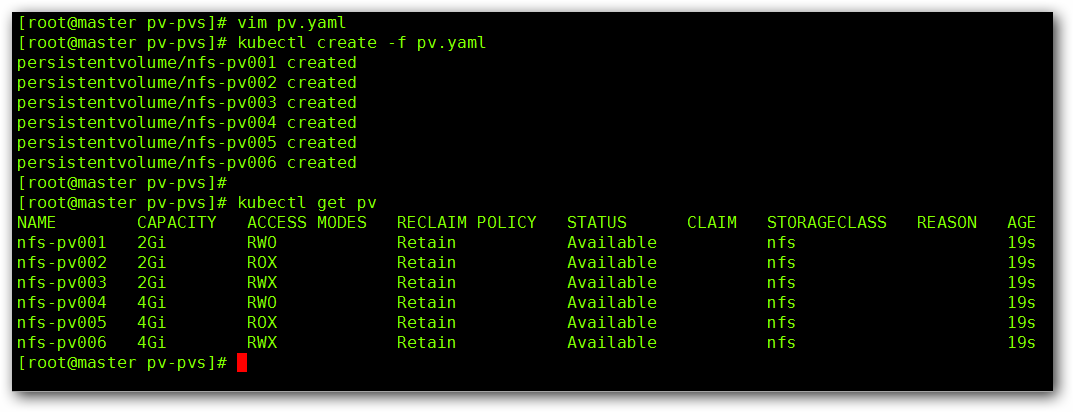
三、创建服务并使用 PVC
| vim statefuset.yaml | |
| apiVersion: v1 | |
| kind: Service | |
| metadata: | |
| name: nginx | |
| labels: | |
| app: nginx | |
| spec: | |
| ports: | |
| - port: 80 | |
| name: web | |
| clusterIP: None | |
| selector: | |
| app: nginx | |
| apiVersion: apps/v1 | |
| kind: StatefulSet | |
| metadata: | |
| name: web | |
| spec: | |
| selector: | |
| matchLabels: | |
| app: nginx | |
| serviceName: "nginx" | |
| replicas: 3 | |
| template: | |
| metadata: | |
| labels: | |
| app: nginx | |
| spec: | |
| containers: | |
| - name: nginx | |
| image: docker.io/nginx | |
| imagePullPolicy: IfNotPresent | |
| ports: | |
| - containerPort: 80 | |
| name: web | |
| volumeMounts: | |
| - name: www | |
| mountPath: /usr/share/nginx/html | |
| volumeClaimTemplates: | |
| - metadata: | |
| name: www | |
| spec: | |
| accessModes: [ "ReadWriteOnce" ] | |
| storageClassName: "nfs" | |
| resources: | |
| requests: | |
| storage: 1Gi |
创建后我们来看一下效果,首先看一下 Pod 的创建过程:
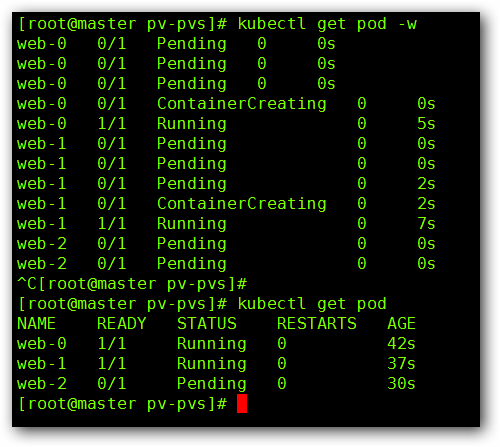
然后我们来看一下 PV 的状态:

通过上述实验截图,我们发现,我们定义了三个副本,但是只有两个副本处于“running”的状态,还有一个处于“pending”的状态,这是因为,我们定的 PV 的访问模式为“ReadWriteOnce”,以单个节点以读 / 写模式挂载,我们在创建 PV 的时候只创建两个模式为“ReadWriteOnce”的 PV,所以第三个 Pod 没有可用的 PV 进行挂载,所以创建不成功。
还有,我们要注意一下 StatefulSet 控制器,在创建的时候它是一个一个按照顺序的进行创建,在删除的时候,也是有序进行的删除。
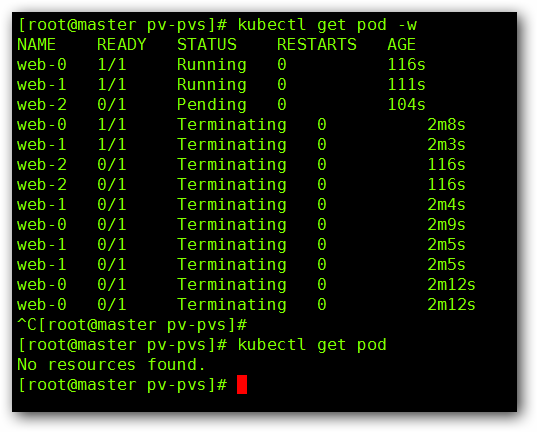
四、PV 资源回收
我们将由 StatefulSet 控制器创建的 Pod 进行删除操作,然后我们在查看一下我们的 PV 的状态:
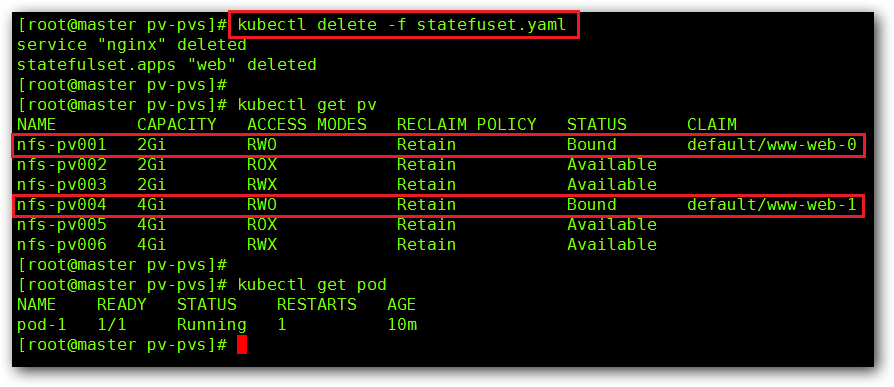
这里,我们可以看到,由 StatefulSet 控制器创建的 Pod 已经全部删除了,但是我们的 PV 资源还没有释放,这是因为我们回收策略的原因所导致的,那么我们来手动回收一下:
通过命令 kubectl edit pv nfs-pv001 来将“claimRef”字段进行删除,然后查看下 PV 状态。
删除“claimRef”前:
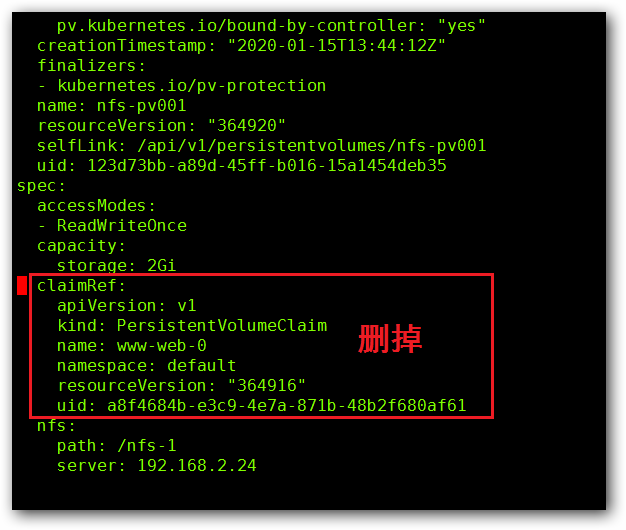
删除“claimRef”后:
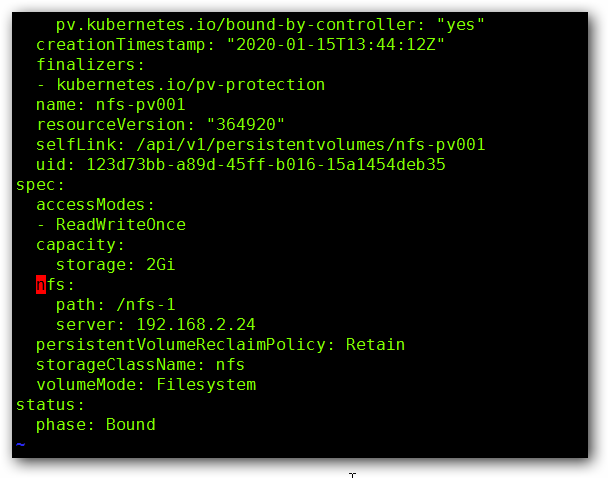
然后查看下 PV 的状态:

正文完
星哥玩云-微信公众号
















